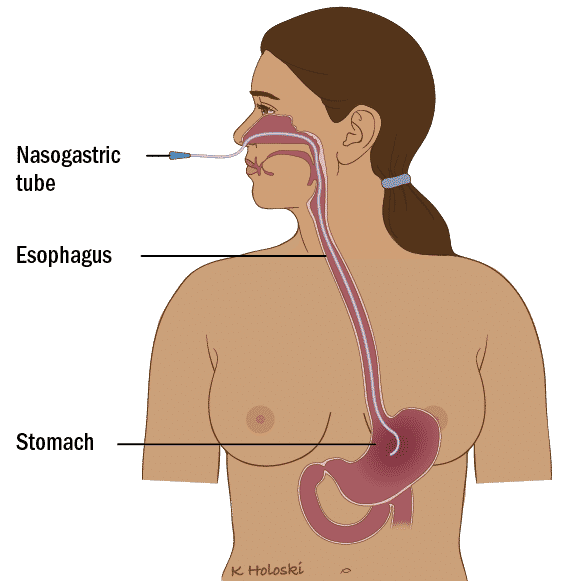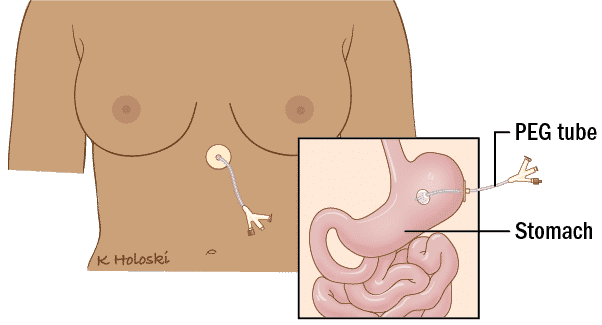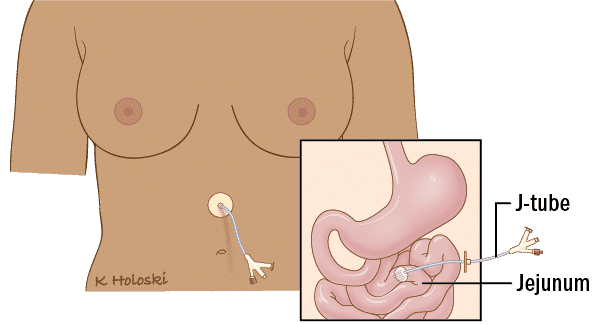Overview
At some point, head and neck cancer patients may experience difficulty with breathing or eating. This can occur before, during, or after treatment and may be related to their cancer or to the treatment of their cancer. While some mild changes in breathing or swallowing may be observed, treatment will be required when severe complications such as respiratory compromise or significant weight loss occur.
For patients that are unable to eat or have difficulty with eating, a surgeon can place a feeding tube directly into the patient’s stomach. These feeding tubes are often temporary and are easily removed once the patient’s ability to eat has improved. Patients that struggle with breathing may need a tracheotomy, a procedure to insert a tube into the windpipe (trachea) to assist with breathing. Tracheotomies are easily reversible procedures and are often temporary in many head and neck patients. See below for further information on these procedures.
Feeding Tubes
A feeding tube is a tube that directly enters the stomach to deliver nutrition; therefore bypassing the mouth, throat, and esophagus. The simplest form of a feeding tube is a nasogastric tube that is inserted through the nose guided into the stomach. An alternative approach which is used when the duration of a feeding tube is anticipated to be longer, involves the direct placement of a tube into the stomach, through the abdominal wall. In many cases, a feeding tube is only temporary. Once a patient is able to resume eating by mouth, the tube can be easily removed.
Situations That May Require a Feeding Tube
Swallowing Blocked by Tumor
If there is a tumor in the throat or esophagus that prevents a patient from receiving enough nutrition by mouth, they may require a feeding tube. This will ensure that the patient is receiving adequate nutrition and can remain as healthy as possible during treatment.
Side Effects of Treatment
Both surgical and nonsurgical treatments may cause significant difficulty in swallowing. Short term complications of treatment may include swelling, pain, and mucositis (inflammation of the digestive tract mucous membrane). Long term complications such as esophageal strictures (narrowing of the esophagus) are also possible. All of these side effects may cause difficulty or pain when swallowing, which can be bypassed with a feeding tube.
Aspiration
Patients may experience aspiration in which food and/or liquid enters the lungs. This poses a risk for developing an aspiration-related pneumonia (an infection in the lungs). If aspiration remains after swallow therapy and dietary adjustments, a patient may need to refrain from eating by mouth and use a feeding tube instead.
Salivary Leak
This refers to a leaking of saliva from the mouth or throat into the neck. It can be a complication of surgery, especially in patients who have previously been treated with radiation. Salivary leaks can cause infection in the neck, as well as a host of other problems. To treat this, a patient may not eat or drink by mouth for a period of time and will require a feeding tube for nutrition.
Postoperative Healing
After a surgery in the mouth and/or throat, the patient may need to avoid eating or drinking through the mouth until they are fully healed. To maintain adequate nutrition as the wounds heal, a patient will most likely need a feeding tube.
Different Types of Feeding Tubes
Nasogastric Feeding Tube (NG tube)
This is a long, thin tube placed through the nose passing through the throat and esophagus into the stomach. This type of tube is typically used immediately after surgery for only one or two weeks, until enough postoperative healing has occurred that a patient can safely eat and drink by mouth. The NG tube can safely remain in place for longer than 2 weeks, but it can be uncomfortable and cannot be hidden from view as well as a gastric feeding tube.


Gastric Feeding Tube (G-tube)
This type of tube is placed directly through the abdominal wall and into the stomach. It is typically used for patients who require a feeding tube for more than two weeks. In some cases, the doctor may suggest that patients eat some nutrition by mouth and use the gastric tube for additional nutritional intake. The G-tube can be easily hidden underneath clothing. Gastrostomy tubes can be inserted in a number of different ways: by an open surgical procedure with an incision in the abdomen; through an endoscopic approach where the tube is placed into the stomach during direct visualization through and esophagoscope (commonly referred to as a PEG, percutaneous, endoscopic gastrostomy tube); or with interventional radiology.
Jejunal Feeding Tube (J-tube)
A J-tube is similar to the G-tube, but instead of entering the stomach wall, it enters the second part of the small bowel called the jejunum. A J-tube is connected to a pump that provides nutrition over an extended period of time. J-tubes are used less frequently than G-tubes, and are generally used in cases where the tube will be needed for an extended period of time, or where a G-tube cannot be used, often due to an obstruction

Risks of Using a Feeding Tube
Like any procedure, there are risks associated with placing a feeding tube. While risk occurrence is low, it is important to be mindful of the following:
- An NG tube is usually sutured in place at the nose and may cause some pain and tenderness of the nasal septum.
- For a G-tube and J-tube, bleeding and infection at the insertion site may occur. Additionally, if the tube is placed through the wrong passage, infection of the abdomen may occur. Constipation is another risk, but it can be prevented with medications.
Tracheotomy
A tracheotomy is a procedure in which a tube is inserted through the neck directly into the windpipe or trachea to aid breathing. It can also be used to suction and clean the lungs. For head and neck cancers, a tracheotomy might be considered in the following situations:
- Upper airway obstruction: If breathing is blocked because of a large tumor or swelling in the mouth and/or throat, a tracheotomy might be necessary. A patient might also receive a tracheostomy tube during surgery in anticipation of significant swelling that could obstruct breathing.
- Cleaning the lungs: Some people have a lot of secretions in their lungs, possibly from chronic aspiration or from being too weak to effectively cough and clear their lungs. If this is the case, a tracheostomy can be used to help keep the lungs clean.
- Prolonged oral intubation: If the patient requires a breathing tube with ventilator support for an extended period of time, their doctors might recommend a tracheostomy tube. A tracheostomy tube is more comfortable, so the patient doesn’t have to be sedated. It also avoids complications that may arise from a tube sitting in the voice box for a prolonged period.
What to Expect with a Tracheostomy Tube
When a tracheostomy tube is first inserted, there will be some irritation and coughing. With a large or cuffed tracheostomy tube, the patient will not be able to speak initially. After a few days, patients are often changed to a smaller and uncuffed tracheostomy tube and will be able to speak with the new tube in place. The secretions and coughing will also decrease as their trachea gets used to the tube.
It is important to keep the tube clean to prevent it from getting blocked or infected. Patients with a tracheostomy should learn to suction the tube. In some cases, they will be sent home with a suction machine. Humidified air is also important when breathing through a tracheostomy tube. Because a tracheostomy tube bypasses normal humidification structures in the nose and throat, patients with a tracheostomy should have a humidifier in their house.
A capping trial is used to test if a patient is ready to have their tracheostomy tube removed. A cap is placed over the tracheostomy tube, and the patient is required to breathe completely through their nose and mouth. If the cap has to be removed for any reason, such as breathing difficulty or a need to suction, the tracheostomy tube is not ready to be removed. If the cap can remain on for 48 to 72 hours, the patient is ready to have the tube removed. Once the tube is removed, the hole will be covered and should close within a week. If the hole does not heal within a couple of weeks, the patient might need a minor procedure in the operating room to seal the opening.
Risks of a Tracheostomy Tube
Every procedure has risks, including bleeding and infection. If a patient notices any signs of infection, including pain and redness around the tracheostomy tube site, or experiences bleeding from their tube, they should call their doctor. If the tube comes out and cannot be replaced, it may be necessary to go to the emergency room.

Top Questions for Your Doctor
Access our list of the most important questions to ask your physician at your next appointment.












